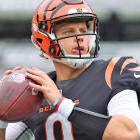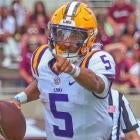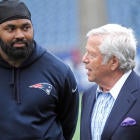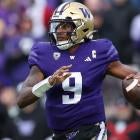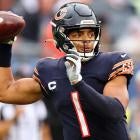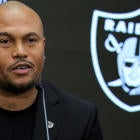
You might be surprised to know that Joe Burrow prefers turf football fields over grass ones. While most players appear to prefer grass surfaces, the Cincinnati Bengals quarterback says that he feels faster when playing on turf. Burrow would know, as he led LSU to national title inside a turf-clad Superdome before leading the Bengals to the Super Bowl last season while playing his home games on turf.
Burrow was asked about the league's playing surfaces amid NFLPA president JC Tretter's recent request for the NFL to improve playing surfaces to decrease unnecessary injuries. Tretter, after taking feedback from players who have expressed concern about some of the league's playing surfaces, has asked the NFL -- among other things -- for an immediate ban of slit film turf. Burrow's team is one of six NFL teams that currently using slit film turf.
"Field quality is the first thing you notice when you walk out there," said Burrow, whose season-ending knee injury in 2020 occurred on a grass field. "Changes the cleats you wear. Changes how you cut, how you run routes, all the above. So I think having a universal turf would be a great thing for for us as players. I don't know the stats on it, or injuries or anything, based off of the playing surface.
"I personally like like playing on turf, but I do wish that each stadium had the same turf."
Burrow's comments come after Packers quarterback Aaron Rodgers challenged the NFL to look deeper into the correlation between field surfaces and player safety. Rodgers is an advocate for playing on grass fields.
"As much as I've enjoyed playing indoors over the years on turf, I do think it's time to play on grass," Rodgers said. "I think you'd see less of these non-contact injuries."
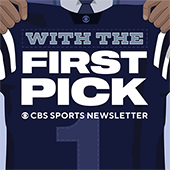
With The First Pick Newsletter
With The First Pick Newsletter
Prepare for the upcoming NFL Draft with the day’s big stories + mock drafts, big board updates and more.
Thanks for signing up!
Keep an eye on your inbox.
Sorry!
There was an error processing your subscription.
In a letter issued through the NFLPA's website, Tretter noted that games played on slit film turf have higher in-game injury rates compared to other playing surfaces. Non-contact injuries and foot and ankle injuries are among the injuries that statistically occur more on slit film turf, according to Tretter.
"The NFL and its experts have agreed with this data and acknowledge that the slit film field is less safe," Tretter wrote. "Player leadership wrote a letter to the NFL this week demanding the immediate removal of these fields and a ban on them going forward, both in stadiums and for practice fields. The NFL has not only refused to mandate this change immediately, but they have also refused to commit to mandating a change away from slit film in the future at all."
Tretter is also asking the NFL to not allow games to be played on fields with clear visual abnormalities. He also wants the NFL to raise the field standards and test the safety and performance of all field surfaces. Lastly, Tretter called on the NFL to clear excess people and dangerous equipment from the sidelines.
"We play one of the most dangerous sports in the world; it shouldn't be more dangerous because the clubs won't do anything to remove the simple injury risks on practice and playing surfaces," Tretter wrote. "If the league wants to actually use data to drive its decisions, then do it already. We've been waiting for years for some of these changes."
Tretter's concerns regarding slit film turf have merit. Just ask the 49ers, who lost a host of players in 2020 after San Francisco played games at MetLife Stadium, which is one of the stadiums that currently uses slit film turf. Richard Sherman, a 49ers cornerback at the time and currently the NFLPA vice president, called on the NFL to ban slit film turf while using his spotlight as an Amazon analyst for Thursday night games.
"It needs to change immediately," Sherman said, via Cincinnati.com. "The league champions player safety. And when there's clear evidence of a playing surface being dangerous -- there's nine more serious injuries on this surface than even other turfs -- like, you need to change it now.
"You get on it immediately. There has been 15-18 more injuries just this season. So that data that they compiled hasn't included this season. … As a player, there's no reason for that kind of risk. These are outdoor stadiums. … They can change that. The indoor stadiums -- cool, there's an argument there. But when you can change the surface, it should be grass. … Player safety is nonnegotiable."













